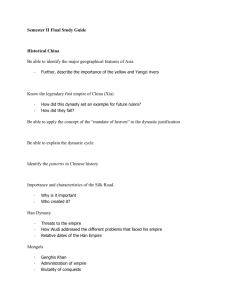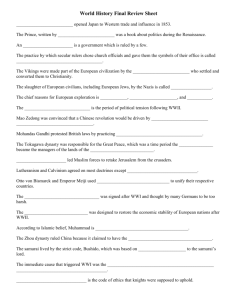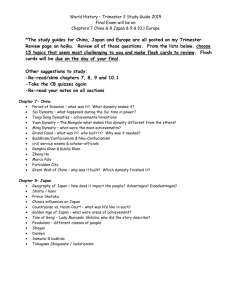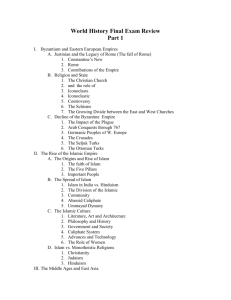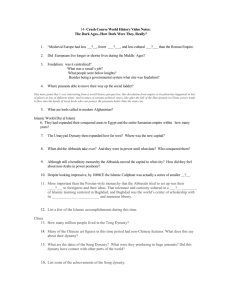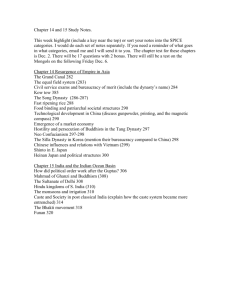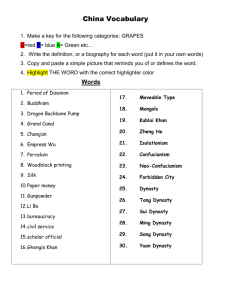Final Exam Review
advertisement
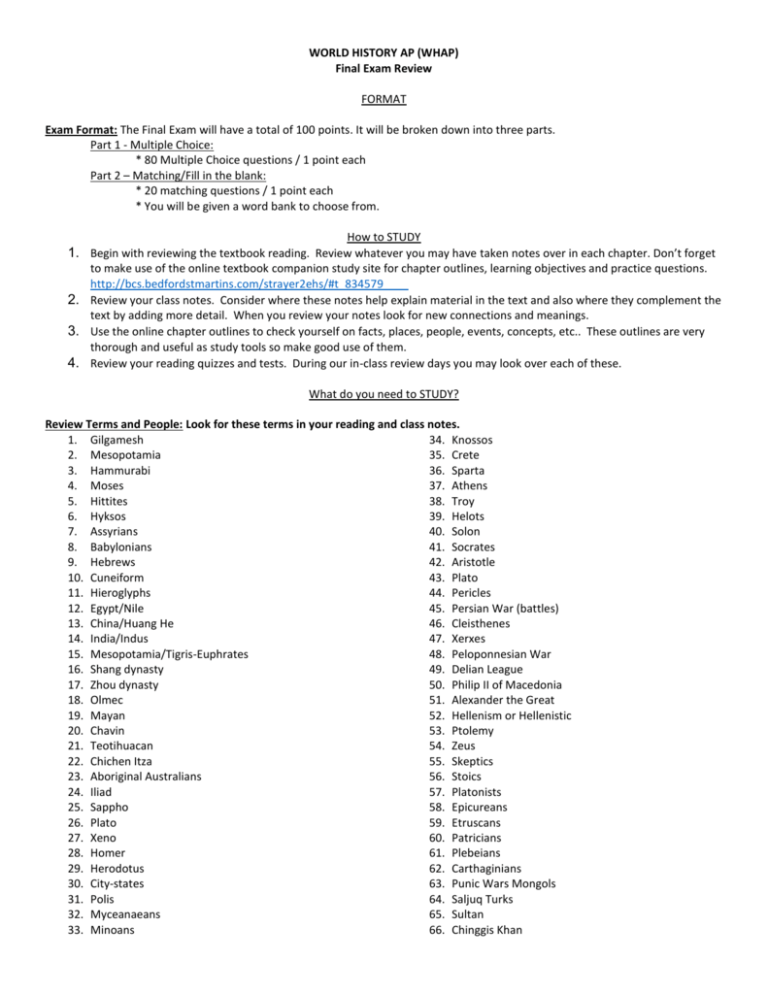
WORLD HISTORY AP (WHAP) Final Exam Review FORMAT Exam Format: The Final Exam will have a total of 100 points. It will be broken down into three parts. Part 1 - Multiple Choice: * 80 Multiple Choice questions / 1 point each Part 2 – Matching/Fill in the blank: * 20 matching questions / 1 point each * You will be given a word bank to choose from. How to STUDY 1. Begin with reviewing the textbook reading. Review whatever you may have taken notes over in each chapter. Don’t forget to make use of the online textbook companion study site for chapter outlines, learning objectives and practice questions. http://bcs.bedfordstmartins.com/strayer2ehs/#t_834579____ 2. Review your class notes. Consider where these notes help explain material in the text and also where they complement the text by adding more detail. When you review your notes look for new connections and meanings. 3. Use the online chapter outlines to check yourself on facts, places, people, events, concepts, etc.. These outlines are very thorough and useful as study tools so make good use of them. 4. Review your reading quizzes and tests. During our in-class review days you may look over each of these. What do you need to STUDY? Review Terms and People: Look for these terms in your reading and class notes. 1. Gilgamesh 34. Knossos 2. Mesopotamia 35. Crete 3. Hammurabi 36. Sparta 4. Moses 37. Athens 5. Hittites 38. Troy 6. Hyksos 39. Helots 7. Assyrians 40. Solon 8. Babylonians 41. Socrates 9. Hebrews 42. Aristotle 10. Cuneiform 43. Plato 11. Hieroglyphs 44. Pericles 12. Egypt/Nile 45. Persian War (battles) 13. China/Huang He 46. Cleisthenes 14. India/Indus 47. Xerxes 15. Mesopotamia/Tigris-Euphrates 48. Peloponnesian War 16. Shang dynasty 49. Delian League 17. Zhou dynasty 50. Philip II of Macedonia 18. Olmec 51. Alexander the Great 19. Mayan 52. Hellenism or Hellenistic 20. Chavin 53. Ptolemy 21. Teotihuacan 54. Zeus 22. Chichen Itza 55. Skeptics 23. Aboriginal Australians 56. Stoics 24. Iliad 57. Platonists 25. Sappho 58. Epicureans 26. Plato 59. Etruscans 27. Xeno 60. Patricians 28. Homer 61. Plebeians 29. Herodotus 62. Carthaginians 30. City-states 63. Punic Wars Mongols 31. Polis 64. Saljuq Turks 32. Myceanaeans 65. Sultan 33. Minoans 66. Chinggis Khan 67. Khubilai Khan 68. Khanbaliq 69. Marco Polo 70. Golden Horde 71. Tamerlane 72. Samarkand 73. Ottoman Turks 74. Osman 75. Constantine 76. Diocletian 77. Theodosius 78. Zhang Qian 79. Alaric 80. Attila 81. “tetrarchs” 82. “barracks emperors” 83. Manichaeism 84. Essenes 85. Epictetus 86. Patricians 87. Plebeians 88. Tiberius Gracchus 89. Carthage 90. Paul of Tarsus 91. St. Augustine 92. St. Cyprian 93. Latifundia 94. Pax Romana 95. Stoicism 96. Legalism 97. Neo-Platonism 98. Twelve Tables 99. Ten Commandments 100. Sinicization- pax sinifica 101. Dar al-Islam 102. Hijra 103. Muhammad 104. Abu Bakr 105. Ali 106. Abbasid 107. Byzantine empire 108. Ottoman Turkish Empire 109. Sasanid Empire 110. Saljuq Turks 111. Sufi 112. Sunni 113. The Rubaiyat 114. The Quran (all aspects) 115. Sundiata 116. Jenne 117. Niani 118. Kongo 119. Ghana 120. Bantu 121. Axum 122. Swahili 123. Songhay 124. Mali 125. Ibn Battuta 126. Mansa Musa 127. Zimbabwe 128. importance of camels 129. importance of bananas in Afirca 130. Islam 131. Ramadan 132. Hajj 133. Jihad 134. Trans-Saharan and Indian Ocean Trade 135. Qin Shihuangdi 136. Grand Canal 137. Confucius 138. Equal field system 139. Civil service examinations 140. Tang Dynasty (formation, expansion, fall) 141. Song Dynasty (formation, expansion, fall) 142. Sui Dynasty (formation, expansion, fall) 143. Fast ripening rice 144. Foot binding 145. Magnetic compass 146. Tang and Song Banking practices 147. Dunhuang 148. Dharma = Dao 149. Japanese Zen Buddhism 150. Shintoism 151. Kamakura shogunate 152. Heian period 153. Shogun 154. Samurai 155. Tang shogunate 156. Viet people relations with China 157. Fall of the Gupta dynasty (reunited India when?) 158. Ashoka 159. the Delhi sultanate. 160. the kingdom of Angkor 161. Role of Hindu Temples 162. Establishment of caste system in southern India 163. Ramayana 164. bhakti movement 165. Funan 166. Rivers: Mekong, Irrawaddy, Salween, Huang He, Yangzi 167. Angkor Thom and Angkor Wat 168. Paramesvara 169. “middle ages” 170. Byzantine Empire 171. Caesaropapism 172. Justinian 173. Theodora 174. Constantinople 175. Hagia Sophia 176. Charlemagne 177. Corpus iuris civilis 178. Vikings 179. Feudalism 180. Lord 181. Vassal 182. Serf 183. Pope Leo III 184. Pope Gregory I 185. Pope Benedict II 186. St. Augustine 187. St. Basil 188. Holy Roman Empire 189. Hugh Capet 190. William the Conqueror 191. Norman Invasion 192. Hanseatic League 193. Guilds (merchant and craft) 194. Apprenticeship system 195. Dominican order- maybe missionary groups? 196. Franciscan order 197. Waldensian order 198. Reconquista 199. Castille 200. Aragon 201. Granada 202. Templars 203. Hospitallers 204. Teutonic Knights 205. Pope Urban II 206. The Crusades 207. Aristotle (rediscovery in Enlightenment) 208. Medieval Universities 209. the great dying 210. Columbian Exchange 211. peninsulares 212. mestizo 213. mulattoes 214. plantation complex 215. settler colonies 216. Siberia 217. yasak 218. Qing dynasty 219. Mughal Empire 220. Akbar 221. Aurangzeb 222. Ottoman Empire 223. Constantinople, 1453 224. devshirme 225. Indian Ocean commercial network 226. trading post empire 227. Philippines (Spanish) 228. British/Dutch East Indian Companies 229. Tokugawa shogunate 230. “silver drain” 231. Potosí 232. “soft gold” 233. African Diaspora 234. Benin 235. Dahomey 236. Protestant Reformation 237. Counter-Reformation 238. Taki Onqoy 239. Jesuits in China 240. Wahhabi Islam 241. Wang Yangmin 242. kaozheng 243. Sikhism 244. Copernicus 245. Newton 246. European Enlightenment 247. Voltaire 248. Condorcet and the idea of progress Review Questions: 1. During what early Chinese dynasty was there a first attempt to organize public life on a large scale? 2. What was the “Period of the Warring States”? 3. What Chinese dynasty/ruler was responsible for burning much of early Chinese literature? 4. What was the largest single building in Mesoamerica? 5. What was the basis of many Oceanic languages, including Malayan, Filipino, Polynesian, etc.? 6. What was the most important port in the Hellenistic world? 7. What was the eastern most point of Alexander the Great’s conquests? 8. Which Hellenistic empire had the greatest Greek influence? And was the wealthiest Hellenistic empire? 9. Why was St. Paul’s case deferred to Rome? 10. According to legend who founded Rome? 11. What was the title of the two leaders elected by patricians in the early stages of the Roman Republic? 12. What was unique about the status of Roman policy towards conquered peoples? 13. Who was the major rival to Rome during its early period of expansion? 14. What island was the focal point of the Punic wars? 15. What was the impact of Mongol domination on long distance trade? 16. The Ottoman campaign culminated in 1453 when what leader captured the Byzantine capital of Constantinople? 17. Explain the process of “wandering” by nomadic peoples. 18. In 1295, the Ilkhan Ghazan converted to which religion, causing it to become the favored religion in Persia? 19. What dynasty did Khubilai Khan proclaim or create in 1279? 20. List the things done by Julius Cesar after naming himself dictator in 46 BCE. 21. By the second century CE, how much of Rome’s imperial population were slaves? 22. What was the easternmost point of the Silk Road? 23. 24. 25. 26. 27. 28. 29. 30. 31. 32. 33. 34. 35. 36. 37. 38. 39. 40. 41. 42. 43. 44. 45. 46. 47. 48. 49. 50. 51. 52. 53. 54. 55. 56. 57. What was the westernmost point of the Silk Road? What can we learn from the fact that some Southeast Asian kings called themselves Rajas? What prophet promoted a syncretic blend of Zoroastrian, Christian, and Buddhist elements? Peasant discontent in China led to an uprising known as what? When did this take place? Which Germanic tribe played the most important role in establishing the foundations of European development? What event took place in 1054 between the Pope and the Patriarch of Constantinople? What Russian leader converted to Orthodox Christianity in 989? Which early European state developed the most centralized political structure? What factors helped to increase agricultural production in the high Middle Ages? What was the population in Europe around 1300? Explain the rise of urban society in the high middle ages. Who discovered Newfoundland in 1000 CE? Which Crusade recaptured Jerusalem? Which Muslim leader recaptured Jerusalem in 1187? What impact did the growth of towns and cities have on labor? Which European power established hegemony over the Indian Ocean trade during the 1500s? What was the Treaty of Tordesillas and why was it important? Explain the shift of European commercial activity from the Mediterranean to the Atlantic during the 16 th century. Explain the extent of Westernization in Russia, including changes to dress, grooming, education, etc. What was the larger significance of Magellan’s ship and crew’s return to Spain in 1522? Why were the Portuguese able to assert control over trade in the Indian Ocean? List all the factors that contributed to Spain’s ability to quickly create a vast empire in the Americas. What was the emphasis of the Renaissance philosophy of humanism? What changes took place in the shape of government in Great Britain and France during the period 1450-1750? Explain what an Absolute Monarchy is and list several examples of such a governmental system. Also what were the characteristics of these monarchies? What were the immediate reasons given by Martin Luther as his protest against the Catholic Church? Also what was his main philosophical or theological disagreement with the Church? When was the Spanish Armada defeated? What did this signal for both Spain and for Great Britain? Why did the Copernican explanation for the universe find more critics than supporters when it was first put forward? Explain how the period of 1450-1750 saw the balance of world power shift to Europe. What factors helped to facilitate this shift? What were the various social groups in New Spain? Which groups held the highest status? Which groups held the lowest? What factors helped the Muscovite Russians to initially form political states in Eastern Europe? Comparing the epidemics of the 1500s in Mesoamerica with other epidemics (the Black Death in Europe, global flu pandemics of 1918-1919, the spread of AIDS in 20th century sub-Saharan Africa), explain why that in Mesoamerica caused a great decline in global population. During the period 1600-1700 which product was the principle product (most traded) of the Atlantic trade? What was the outcome of the introduction of the Incan staple crop of potatoes outside of South America? What was the “Columbian Exchange” and what products were native to each hemisphere that had the greatest impact on the opposite hemisphere?

